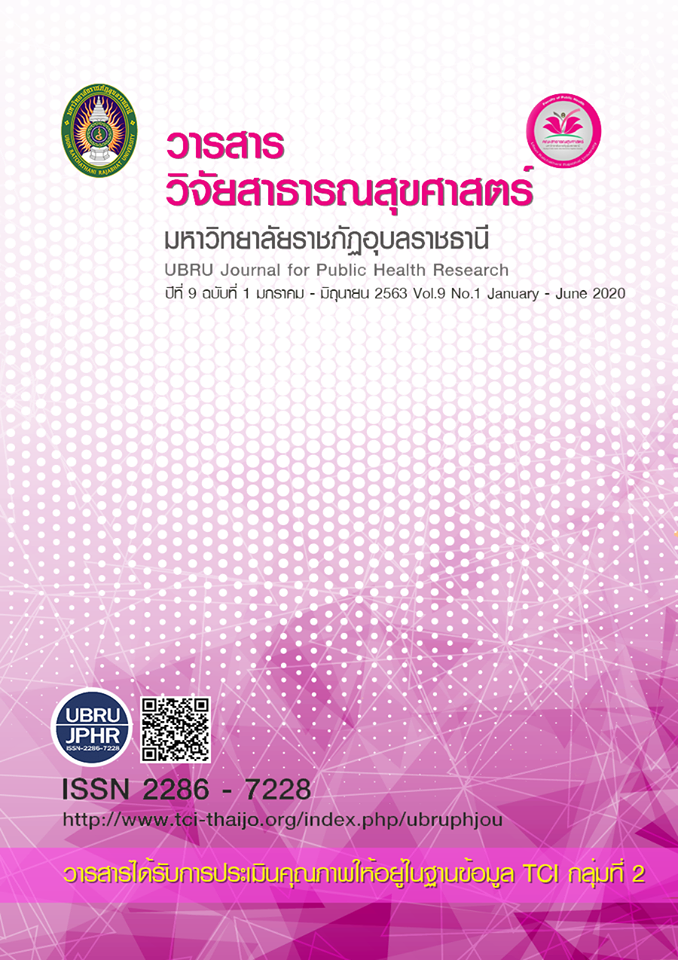Risk score of memory disturbance and dementia in acute ischemic stroke patients
Keywords:
Acute ischemic stroke, risk score, memory disturbance, dementiaAbstract
This study was a cohort study design. That aims to provide the total risk score for predicting memory disturbance and dementia in 401 acute ischemic stroke patients treated at Srinakarin Hospital, Khon Kaen Hospital, and Chum-phae Hospital between January 1 - December 31, 2017. Data were collected by questionnaire and review of medical records three times include before discharge from the hospital, three months, and six months after a diagnosis of acute ischemic stroke. Factors associated with memory disturbance and dementia have been analyzed by logistic regression statistic, and the risk score was defined from β Coefficients of each factor. The sensitivity, specificity, and Receiver operating characteristic (ROC) of the risk score have been calculated. The results of this study demonstrated the factor as gender, age, education level, and severity of stroke can be used to calculate the risk score for predicting the memory disturbance and dementia in acute ischemic stroke patients during three times were 5 points. ROC curve was 0.81, 0.83, and 0.85, respectively. Sensitivity was 76.2%, 80.9%, and 84.1%, respectively. Specificity was 71.8%, 68.7% and 68.6%, respectively. Hence, the risk score obtained from this study can be used to screen patients with acute ischemic stroke for the risk of memory disturbance and dementia.
References
Desmond DW, Moroney JT, Sano M, Stern Y. (2002). Incidence of dementia after ischemic stroke results of a Longitudinal Study. Stroke. 33(9), 2254-2262.
Douiri A, Rudd AG, Wolfe CDA. (2012). Prevalence of post stroke cognitive impairment: South London Stroke Register 1995-2010. Stroke. 44(1), 138-145.
Exalto LG, Biessels GJ, Karter AJ, Huang ES, Katon WJ, Minkoff JR, et al. (2013). Risk score for prediction of 10-year dementia risk in individuals with type 2 diabetes: a cohort study. The Lancet Diabetes & Endocrinology. 1(3), 183-189.
Henon H, Pasquier F, Durieu M, Godefroy O, C Lucas M, F Lebert M, et al. (1997). Preexisting Dementia in Stroke Patients Baseline Frequency, Associated Factors, and Outcome. Stroke. 28(12), 2429-2436.
Hu H-H, Sheng W-Y, Chu F-L, Lan C-F, Chiang BN. (1992). Incidence of stroke in Taiwan. Stroke. 23(9), 1237-41.
Ivan CS, Seshadri S, Beiser A, Au R, Kase CS, Kelly-Hayes M, et al. (2004). Dementia after stroke the Framingham study. Stroke. 35(6), 1264-1268.
Khedr EM, Hamed SA, El-Shereef HK, Shawky OA, Mohamed KA, Awad EM, et al. Cognitive impairment after cerebrovascular stroke: Relationship to vascular risk factors. Neuropsychiatric Disease and Treatment. 2009; 5:103-16.
Khor, GL. (2001). Cardiovascular epidemiology in the Asia–Pacific region. Asia Pacific journal of clinical nutrition. 10(2), 76-80.
Kivipelto M, Ngandu T, Laatikainen T, Winblad B, Soininen H, Tuomilehto J. (2006). Risk score for the prediction of dementia risk in 20 years among middle aged people: a longitudinal, population-based study. The Lancet Neurology. 5(9), 735-741.
Klimkowicz-Mrowiec A, Dziedzic T, Słowik A, Szczudlik A. (2006). Predictors of post stroke dementia: results of a hospital-based study in Poland. Dementia and geriatric cognitive disorders. 21(5-6), 328-34.
Knofczynski GT, Mundfrom D. (2007). Sample sizes when using multiple linear regression for prediction. Educational and Psychological Measurement. 68(3), 431-442.
Lin J-H, Lin R-T, Tai C-T, Hsieh C-L, Hsiao S-F, Liu C-K. (2003). Prediction of post stroke dementia. Neurology. 61(3), 343-348.
Mellon L, Brewer L, Hall P, Horgan F, Williams D, Hickey A. (2015). Cognitive impairment six months after ischemic stroke: a profile from the ASPIRE-S study. BMC neurology. 15(1), 1.
Mendis, S. (2014). Global status report on non-communicable diseases. WHO.
Mirza SS, Portegies ML, Wolters FJ, Hofman A, Koudstaal PJ, Tiemeier H, et al. (2016). Higher Education Is Associated with a Lower Risk of Dementia after a Stroke or TIA. The Rotterdam Study. Neuroepidemiology. 46(2), 120-127.
Pendlebury ST, Rothwell PM. (2009). Prevalence, incidence, and factors associated with pre-stroke and post-stroke dementia: a systematic review and meta-analysis. The Lancet Neurology. 8(11), 1006-1018.
Pendlebury, ST. (2009). Stroke-related dementia: rates, risk factors and implications for future research. Maturitas. 64(3), 165-171.
Sullivan LM, Massaro JM, D'Agostino RB, Sr. (2004). Presentation of multivariate data for clinical use: The Framingham Study risk score functions. Statistics in medicine. 23(10), 1631-1660.
Sun J-H, Tan L, Yu J-T. (2014). Post-stroke cognitive impairment: epidemiology, mechanisms and management. Annals of translational medicine. 2(8), 80.
Tamam BT, Nebahat Tamam, Yusuf. (2008). The Prevalence of Dementia Three Months after Stroke and its Risk Factors. Turkish Journal of Psychiatry. 19(1), 1-9.
Tang WK, Chan SSM, Chiu HFK, Ungvari GS, Wong KS, Kwok TCY, et al. (2004). Frequency and Determinants of Post stroke Dementia in Chinese. Stroke. 35(4), 930-935.
Tatemichi T, Paik M, Bagiella E, Desmond D, Pirro M, Hanzawa L. (1994). Dementia after stroke is a predictor of long-term survival. Stroke. 25(10), 1915-1919.
Tatemichi,T.K., Desmond, D., Mayeux, R., Paik, M., Stern, Y., Sano, M., et al. (1992). Dementia after stroke Baseline frequency, risks, and clinical features in a hospitalized cohort. Neurology. 42(6), 1185.
Yang J, Wong A, Wang Z, Liu W, Au L, Xiong Y, et al. (2015). Risk factors for incident dementia after stroke and transient ischemic attack. Alzheimer's & Dementia. 11(1), 16-23.
Downloads
Published
How to Cite
Issue
Section
License
เนื้อหาและข้อมูลในบทความที่ลงตีพิมพ์ในวารสารวารสารวิจัยสาธารณสุขศาสตร์ มหาวิทยาลัยราชภัฏอุบลราชธานี ถือเป็นข้อคิดเห็นและความรับผิดชอบของผู้เขียนบทความโดยตรงซึ่งกองบรรณาธิการวารสาร ไม่จำเป็นต้องเห็นด้วย หรือร่วมรับผิดชอบใดๆ
บทความ ข้อมูล เนื้อหา รูปภาพ ฯลฯ ที่ได้รับการตีพิมพ์ในวารสารนี้ ถือเป็นลิขสิทธิ์ของวารสารฯ หากบุคคลหรือหน่วยงานใดต้องการนำทั้งหมดหรือส่วนหนึ่งส่วนใดไปเผยแพร่ต่อหรือเพื่อกระทำการใดๆ จะต้องได้รับอนุญาตเป็นลายลักอักษรณ์จากบรรณาธิการวารสารนี้ก่อนเท่านั้น


